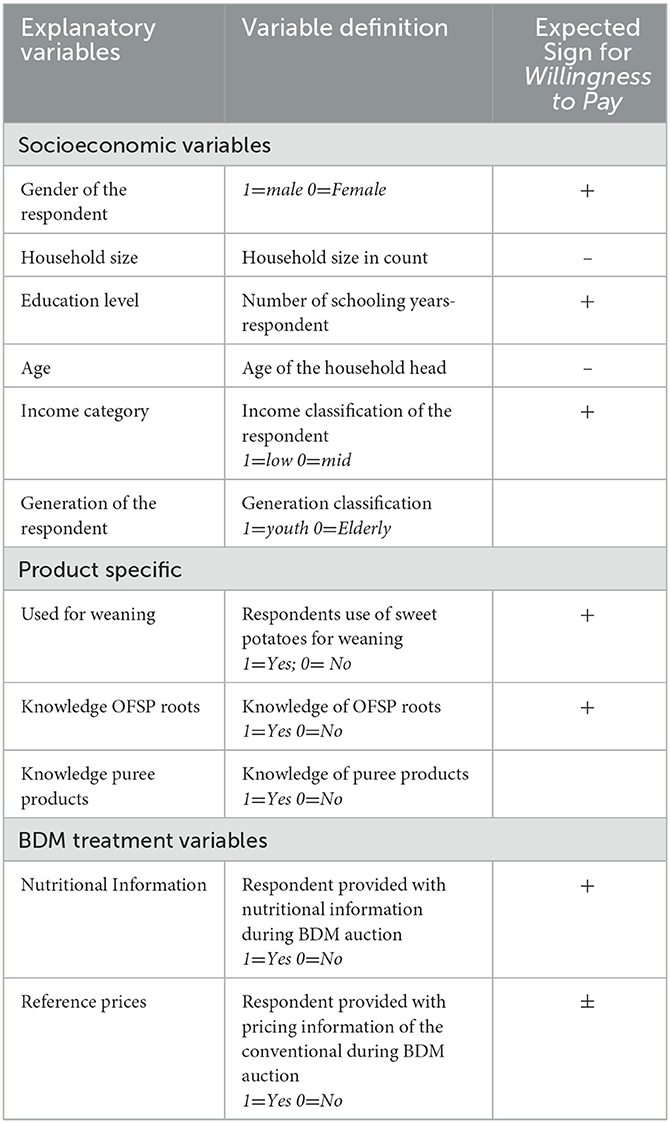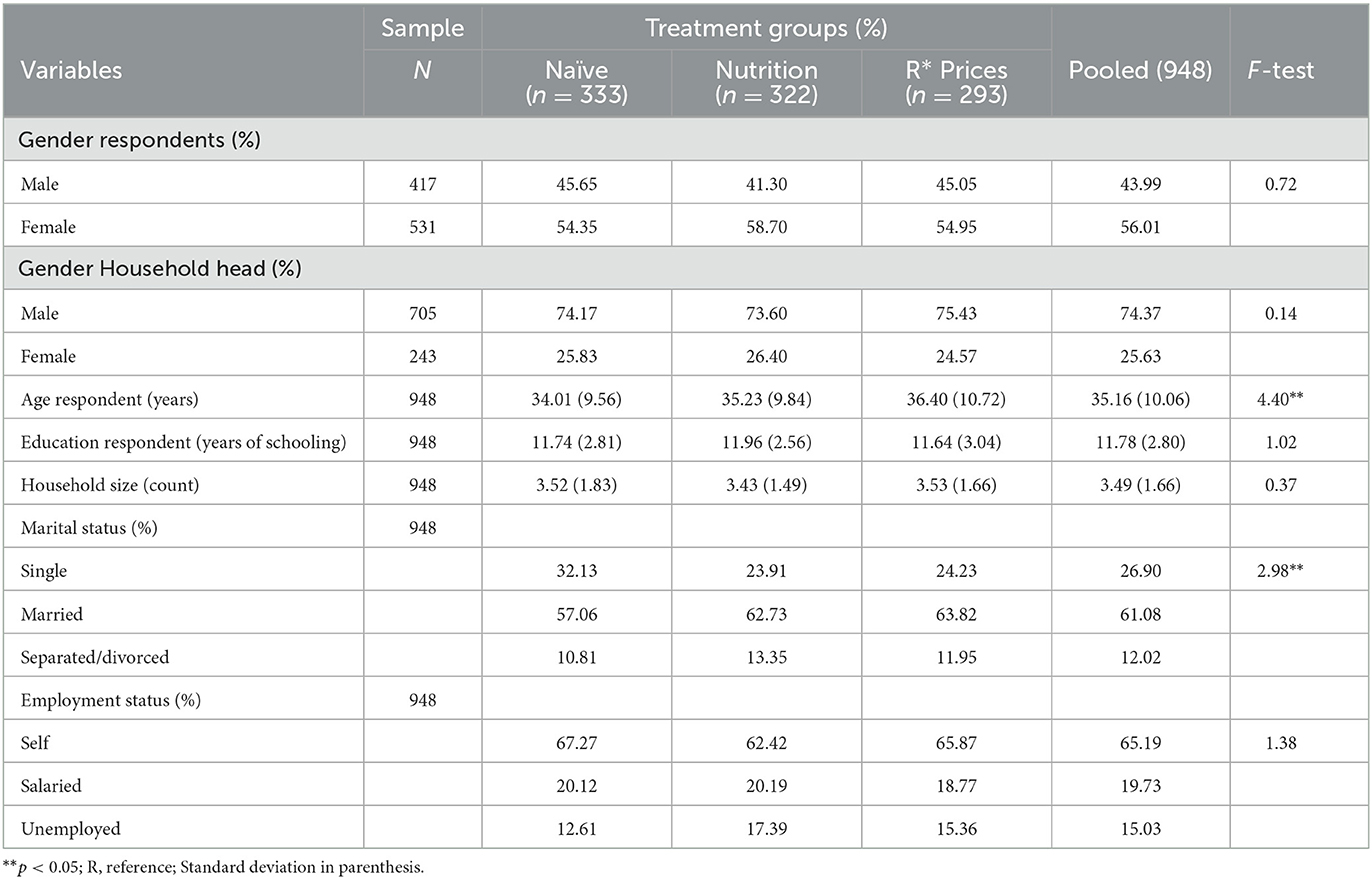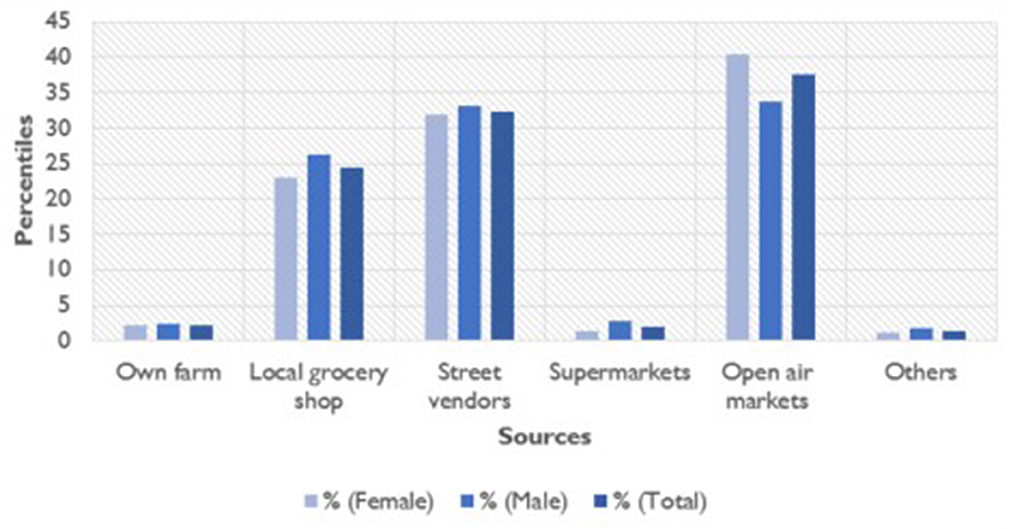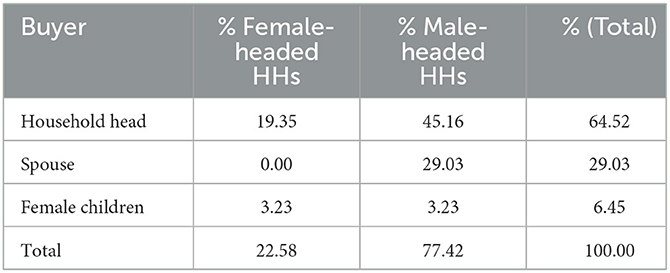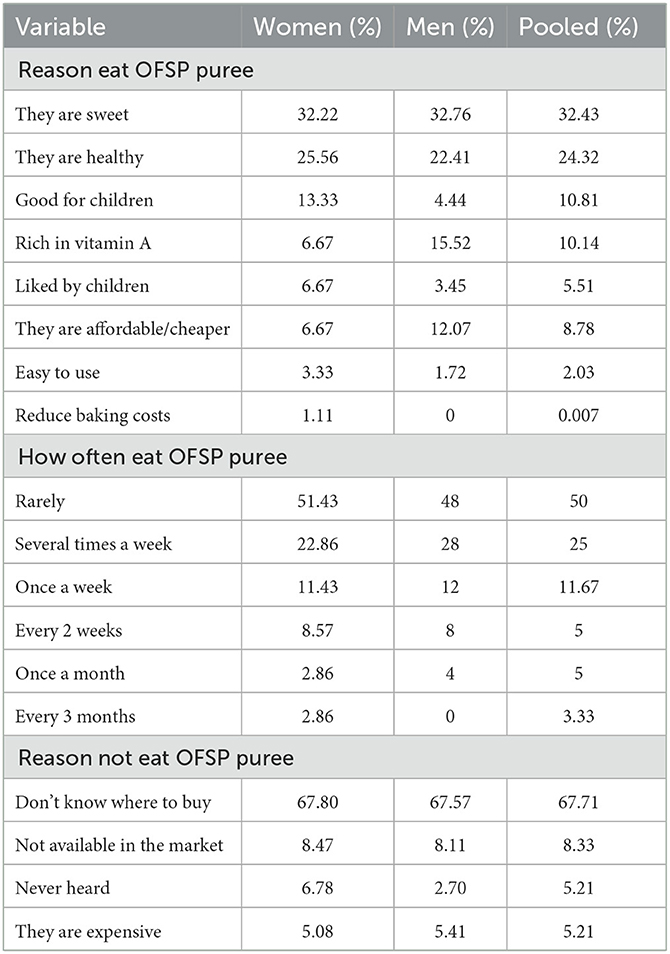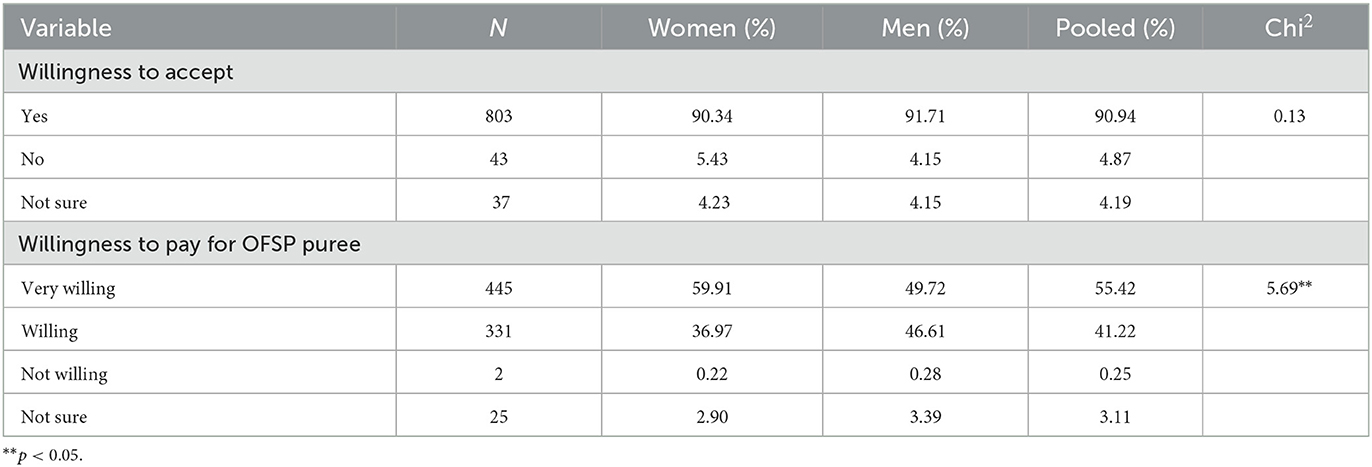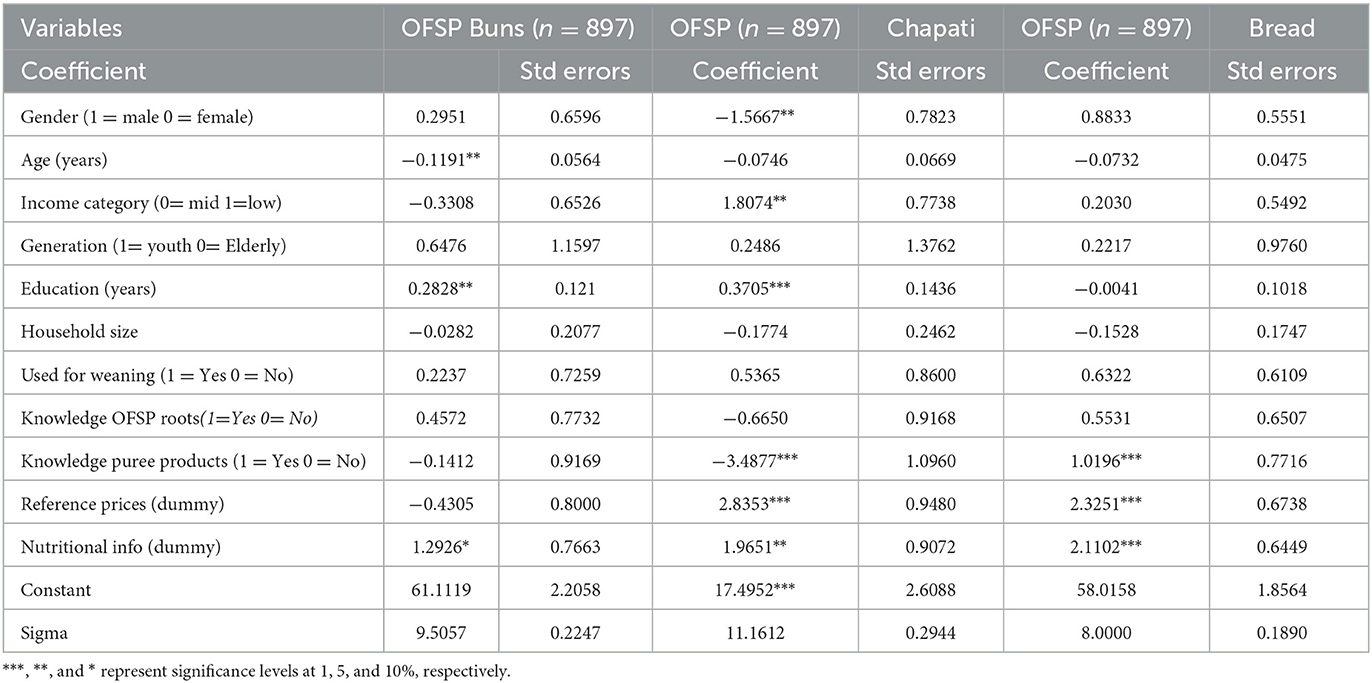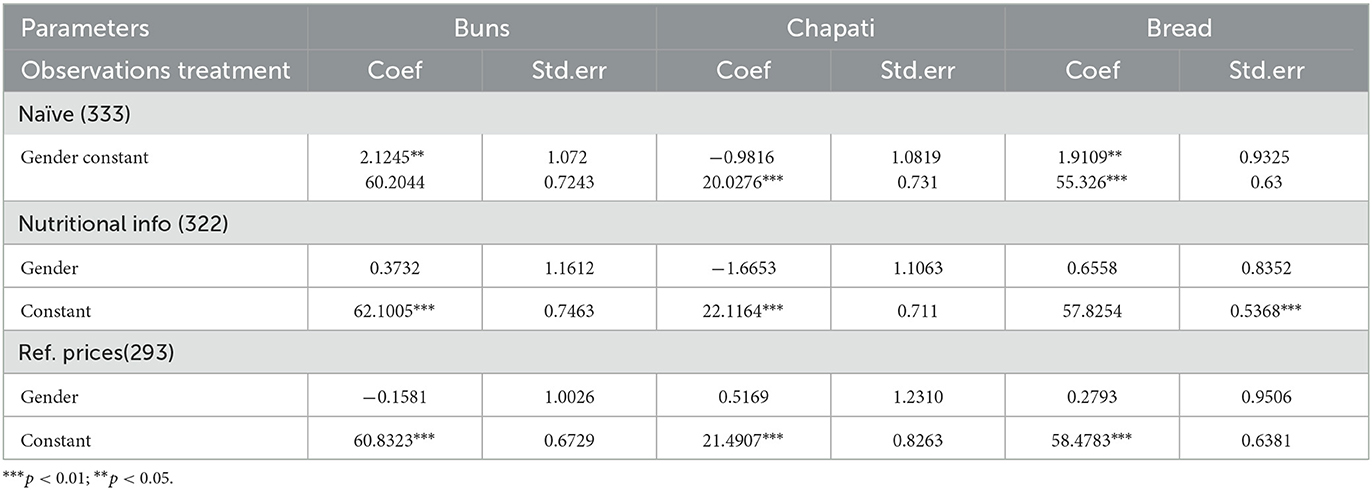- 1International Potato Center, Sub-Saharan Africa Regional Office, International Livestock Research Institute Campus, Nairobi, Kenya
- 2International Potato Center, Kampala Office, Kampala, Uganda
- 3Department of Food, Bioprocessing and Nutrition Sciences, North Carolina State University, Raleigh, NC, United States
- 4International Potato Center, Hanoi, Vietnam
Vitamin A deficiency (VAD) is a major public health problem affecting people of all ages, particularly women of reproductive age and young children in the Global South. Nutrient-enriched (biofortified) orange-fleshed sweet potato (OFSP) has promising potential as a sustainable food vehicle to combat VAD. Part of ongoing efforts to combat VAD, particularly among the urban poor populations, include the introduction of innovative OFSP puree, which is utilized as a functional and substitute ingredient in widely consumed baked and fried products. In Kenya, the OFSP puree is used to make commercial products that are affordable by low- and middle-income households. However, there is limited knowledge of consumer awareness, willingness to pay (WTP), and/or how gender plays a role in the uptake of these products. Following a multistage sampling technique, this study employs the Becker–DeGroot–Marschak (BDM) experimental auction method to assess if men and women consumers—from selected, highly populated low- and middle-income areas of Nairobi County in Kenya—are aware and if they would be willing to pay for OFSP puree products. Integrating gender considerations, we use three of the most widely consumed OFSP puree products, bread, buns, and chapati, and three treatment categories, naive, nutritional information, and OFSP puree substitute products' references prices to deduce the WTP for OFSP puree products among men and women. Results showed limited awareness of OFSP and OFSP puree products among men and women. However, both men and women were willing to pay a premium for the OFSP puree products. The intergender comparison showed that women were more willing to pay a premium for the OFSP puree products than men. Gender, age, education, knowledge of OFSP puree products, income category, availability of nutritional information, and reference pricing stand out as significant determinants of WTP.
1. Introduction
Biofortified orange-fleshed sweet potato (OFSP) is a highly nutritious crop with a relatively higher concentration of beta-carotene (BC) compared to many vegetables, and is also a good source of potassium, fiber, and vitamin B6 (Burri, 2011; Laurie et al., 2015, 2018; Owade et al., 2018; Neela and Fanta, 2019). The root has favorable sensory traits such as color and aroma (Adebisi et al., 2020). OFSP can be used for various industrial applications, having both functional and nutritional properties, in the form of flour or puree. The puree has been used to develop innovative nutrient-dense products (Owade et al., 2018), capable of fighting vitamin A deficiency (VAD) among the most vulnerable groups, mainly women of reproductive health and children below 5 years of age (Hagenimana et al., 2001) whose daily vitamin A (VA) needs are higher than those of other groups. In the bakery sector, OFSP puree can replace up to 40% of wheat, reduces the need for added sugars and sweeteners in products, and enriches the overall nutritional characteristics of a formulation without adversely affecting the flavor (Bocher et al., 2017; Muzhingi et al., 2018; Owade et al., 2018; Wanjuu et al., 2018). Commercial and homemade OFSP puree is presently retailing in the formal commercial market in Kenya, but a substantial volume finds its way into the informal market where products are sold unpackaged and unbranded. Some OFSP puree products developed in Kenya to date include bread, buns, chapatis, “kangumu,” “mandazi,” and “bhajias,” among others.
However, over the years, the acceptability and the availability of the OFSP have been at the household level of production and consumption (Bouis and Saltzman, 2017). While considerable experience has been gained in East Africa on the manufacturing and marketing of highly acceptable bakery products in which 20–45% of wheat flour has been replaced by OFSP puree, knowledge of consumer awareness of the availability of OFSP puree baked and fried products and their WTP for these products is still limited. Commercialization efforts of the OFSP puree products in Kenya by the International Potato Center (CIP) and partners have seen a significant uptake by a section of health-conscious consumers—mostly high-end consumers—who source for the products from selected retailers in the upmarket (Low et al., 2007a,b, 2017; Muzhingi et al., 2016, 2018; Bocher et al., 2017, 2019). However, information on the extent to which economically vulnerable consumers in low- to mid-income urban and peri-urban areas in Kenya are aware of OFSP puree products and their nutritional benefits is limited. Besides, several studies have only focused on consumer preferences and acceptance of OFSP puree products based on sensory and functional attributes of the OFSP puree (Muzhingi et al., 2018; Bocher et al., 2019; Wanjuu et al., 2019). While these studies indicate the readiness of consumers to accept and possibly increase consumption, the information available is small on consumer WTP for such products, especially gender differences and implications for marketing strategies. WTP models, such as the BDM that adopt an experimental auction design using different treatments, have been used in several studies to determine consumer WTP for products and/or services. A significant element for WTP by consumers is the information available to them, mostly on the value proposition of the product or service. Consumers need to know how they will benefit from the product they are buying to inform their buying and price decisions. Numerous efforts to reduce malnutrition have been made, and studies have been conducted on consumer acceptability of fortified foods across developing countries.
Chege et al. (2019), in a study among low-income consumers in Kenya and Uganda, found that providing nutrition information influenced WTP for improved and nutritious porridge flour. De Groote et al. (2018), in an experimental auction, showed that after providing additional information on the products, consumers were willing to pay a modest premium for instant flour, and a big premium for added natural extracts such as carrot but were not willing to pay for macronutrients from natural sources; the study area depicts the Kenyan population with a matching national poverty rate. Candace Jackson et al. (2013) showed that consumers in Botswana were more willing to buy multicomposite porridge flour, a low-cost quality product if they perceived that the ingredients would improve their overall nutritional status and health. Bocher et al. (2019) detail that the frequency of use of a substitute product, sensory attributes, and knowledge of the nutritional benefits of OFSP are significant in determining consumer WTP. This current study explores the influence of nutritional information and reference prices to build on this knowledge gap.
Researchers have studied consumer knowledge, preference, attitudes, and their WTP for foods with the improved nutritional quality, especially in developing economies (Mabaya et al., 2010; Jackson et al., 2013; Birol et al., 2015; De Groote et al., 2018, 2020; My et al., 2018; Bocher et al., 2019; Chege et al., 2019). However, many of these studies broadly focus on foods with enhanced nutritional quality through biofortification as a strategy (Meenakshi et al., 2012; De Groote et al., 2014; Birol et al., 2015) and not on specific foods with altered and improved recipes such as puree-based products (Mabaya et al., 2010; De Groote et al., 2018, p. 201; Bocher et al., 2019; Chege et al., 2019). For instance, in bakery, OFPS puree is estimated to replace up to 40% of wheat flour (Low and van Jaarsveld, 2008; Muzhingi et al., 2018; Owade et al., 2018; Wanjuu et al., 2019) cutting on the production costs while enhancing the nutritional contents of the high-calorie wheat products such as bread, buns, “mandazi,” and “chapatis.” Wanjuu et al. (2019) reported that consumers agreed that the OFSP bread, made from a combination of wheat and OFSP puree could be a good source of energy, especially vitamin A (94%). The authors, however, did not differentiate the knowledge of the products among both men and women. Few studies that attempted to understand the WTP for OFSP puree-based products (Nkokelo, 2016; Bocher et al., 2019; Wanjuu et al., 2019) have used contingent valuation using double or single-bound modeling. While the method is widely used in assessing consumer WTP, it does not create a real market scenario where a potential buyer and consumer visualize, feel, and with information that makes a more informed decision about their WTP.
While the aforementioned studies provide interesting insights into consumer attitudes toward nutritious and biofortified foods, gender gaps and differences in the knowledge, attitude, and practices in the use of OFSP puree products remain unexplored. Besides, while there are several studies on WTP of OFSP puree bread, none has given a focus on WTP across gender. Further, the studies compare the WTP of a single OFSP puree product while consumer preferences could be different. Besides, the studies do not reflect the consumption and purchasing behavior of poor and middle-income consumers who are more vulnerable to micronutrient deficiencies such as VAD, and do not highlight the gender and age differences. To contribute to this knowledge gap, we conducted a gender-responsive study to assess consumers' level of awareness of OFSP puree products and consumer WTP for the products. We concluded the role of gender and generation in the uptake of OFSP puree products. We further analyzed the effect of nutritional information and reference prices on WTP for the VA-rich OFSP puree products while controlling for other socioeconomic and institutional characteristics. The findings of this survey are intended to be used for refinement of the delivery approach through a gendered lens, to reach more households with the nutrient-dense OFSP puree products, as well as inform policy development along the OFSP value chain.
2. Materials and methods
Consumers are ideally rational, and they tend to buy a bundle of goods that they would derive maximum utility from. As such, gauging a consumer's WTP for a service or product is crucial, which not only assists in mapping out competitive strategies but also in developing new products, as well as carrying out value audits (Jayson, 2007; Miller et al., 2011). In relation to healthy and nutritious food products, consumers will integrate information into their utility maximization as they are concerned about the quality and safety of the food they consume (Goktolga et al., 2006). Therefore, a product that gives better benefits is preferred. Besides the context of health consciousness such as vulnerability to VAD, especially among the women of reproductive age and caregivers of children below the age of 5 years, the willingness to pay for nutritionally enhanced products, such as OFSP puree products varies across consumer segments, for example, gender, income, and generation, compared to other products (Miškolci, 2011). In the context of OFSP puree products, consumers will be willing to pay a premium price if the utility accrued is higher than using conventional wheat products. Assuming that ns is the nutritional aspect of OFSP puree product, consumers would be willing to pay a premium (ps) subject to other consumer knowledge and demographic factors if the nutritional component of the conventional wheat products nw is deemed significantly lower than that of OFSP puree products. To elicit this willingness to pay for OFSP puree products, we employ the full-bidding method, Becker–DeGroot–Marschak (BDM).
2.1. Overview of experimental auction
Extensive literature has been generated from estimating WTP, especially for food products. Typically, four methods have been used to estimate WTP, namely, contingent valuation, hedonic prices, conjoint analysis (choice experiments), and experimental auctions (EAs). The EAs method values goods' attributes in terms of consumers' revealed preferences while the former three methods are widely based on stated preferences for new and existing products (Morawetz et al., 2011; Akaichi et al., 2012). Unless it is feasible to combine stated preferences with revealed preferences, the hypothetical nature of contingent valuation and choice experiments is a drawback (Morawetz et al., 2011). As a result, EAs are becoming an important substitute especially to contingent valuation methods as they overcome the hypothetical nature by mimicking the market and the choice process in that they involve a real product and real money exchange (Poole et al., 2007).
Therefore, over the years, EAs have gained recognition among economists, marketers, psychologists, and others (Akaichi et al., 2012; Canavari et al., 2019). They are used to determine the monetary value people put on non-market goods. In EAs, actual products are put up for sale, and the participants are endowed with some money to make the purchase (De Groote et al., 2018, 2020; Maredia and Bartle, 2023). On the WTP, EAs bring out more accurate estimates compared to other methods as they are based on genuine behavior, and not on individual intent, involving real money and products, bringing out consumer preferences ex ante while dispensing real incentives. The classic open-ascending price auction, the second-price sealed-bid auction, and the Becker–DeGroot–Marschak (BDM) approaches are popularly applied. The classic open-ascending price auction (English auction) involves price increment until no participant is willing to bid higher. The highest bidder then gets to buy the product at a price equating to his or her bid. In second-price sealed-bid auctions (Vickrey auction), bidders simultaneously submit their sealed bids (corresponding to their WTP) for good, from which the highest bidder wins. This winner then purchases the good at the price stated by the second-highest bidder in the same auction (De Groote et al., 2011; Chege et al., 2019). This approach is used to elicit a participant's actual WTP. The BDM approach is methodologically equivalent to a second-price sealed-bid auction (Morawetz et al., 2011). However, individual participants are not compared to each other but to a randomly generated number. This approach is not an actual auction but rather a simulated auction used to seek individuals' WTP (Shogren, 2005). The Vickrey auction and the BDM approach are incentive compatible in which participants are provided with an incentive to set their bids (Skuza et al., 2015). This gives them room for truthfully undertaking the bidding process and revealing their actual WTP (Lusk et al., 2004; Shogren, 2005).
In BDM, the bid submitted by the participant is compared to a selling price that is randomly drawn from a distribution of reasonable prices usually defined by the marketer or researcher. This random number represents the market price of the good or product in question. The participant whose bid exceeds or is equal to the randomly drawn price wins the auction and gets to purchase the product at the random price he or she drew. In the case that the participant's bid is lower than the randomly drawn price, he or she does not get a chance to buy the product (loses the auction). The BDM mechanism discourages participants from overbidding. This is because an overbid (bidding higher than their WTP) puts them at risk of paying an increased value than what the product is worth to them. On the other hand, participants are at risk of losing a valued product if they put up a bid lower than their WTP. The BDM approach thus allows participants to reveal their actual WTP for the product so as not to fall on either of the above-mentioned extremes (Becker et al., 1964). As Skuza et al. (2015) detail, BDM is superior to other EAs in that, it is relatively easy to implement in a point-of-purchase setting without creating an artificial choice environment while allowing one or several participants in the experiment at a time preventing participants' bids from becoming affiliated since participants do not bid against each other, instead, the bidding outcome and binding price are determined by drawing from a random distribution. This is a particularly attractive feature in the field where researchers have limited ability to control the flow of traffic in the experiment area, for instance, in our case, controlling the traffic of respondents in urban poor who are all willing to participate.
BDM limitations include it being expensive to conduct bringing about regional and geographical restrictions when selecting subjects. Concurrently, it has been conveyed that the amount of cash issued to participants as their participatory fee in the auction may give rise to biased bids from their side. Lastly, a common occurrence that has been evident is the observation of null bids. This is generally due to the lack of interest by the participants in the goods being auctioned (Lusk and Hudson, 2004). Nonetheless, these limitations can be overcome through a rigorous process of selecting a sample, auction design and recruiting, and implementation aspects (Canavari et al., 2019), which were taken into account in this study.
2.2. Study design
Three OFSP puree products (bread, chapati, and bun) and their conventional wheat products were used to elicit WTP. Using the BDM experimental auction approach, three treatments (naive, information, and reference prices) were applied alternatingly to individuals. The experimental auction model mimicked a real market context where a consumer has a variety of products to choose from and has money to spend on the product. Individual respondents were presented with the three OFSP products alongside their conventional equivalents and asked how much they were willing to pay for each of the products. To reduce bias and contamination within the treatment categories, a respondent would only bid under either of the three treatments, that is, in the three rounds of alternation of the three products, a respondent only quoted prices from either a naive perspective (based on their prior knowledge or the lack of knowledge) and the visual attributes, or he or she was furnished with nutritional information about the OFSP puree products using a stack of photos of OFSP puree products with the nutritional information of OFSP and benefits, or he or she was given reference prices of the counterpart products. In all the treatments, a show-up fee of Kenyan Shillings (KES) 200 (approximately US$2) was given to enable the respondents to take part in the auction considering that most of the respondents were of resource scarce and the likelihood of participating in the experiment without financial facilitation would have been low, and the actual market scenario would not have been created.
2.2.1. BDM experimental auction process
The BDM experiment started with a test round to ensure the respondents understood the process well as described in the following sections.
2.2.1.1. Test auction round
The test round was done using unrelated products (biscuits from three brands). At first, a respondent was given KES 50 (100 KES was approximately US$1 during the study period) to enable them to participate and purchase in the experimental test and encouraged to use it to pay for the products offered in the test. First, an explanation of the auction procedure for respondents to understand by using the delayed steps below while controlling for overstating or understating WTP:
I. I will show you three different types of biscuits (Ginger: 1; Milk: 2; and Digestive: 3), one at a time, and ask you to think of how much you are willing to pay for each.
II. I will ask you to bid for each type of biscuit, one at a time, and I will write down your three bids.
III. I will then ask you to pick a random number (from 1 to 3) to determine which of the three types of biscuits is bidding, i.e., will proceed to auction.
IV. Next, I will ask you to pick another random number to determine the “random price,” for that binding product. This is the price you will pay if you win the auction.
V. If the bid you had offered for that product is higher than or equal to the random price, you win the auction, and you have to buy the product at the value of the random price.
VI. If the bid you set is lower than the random price, you lose the auction, so you keep the money, and you do not receive the product.
To limit respondents from exaggerating their WTP, they were informed of running a risk of having to pay a price above what they valued the product at.
2.2.1.2. Actual auction round
Treatment clusters; Naive, nutritional information, and reference prices were used to assess consumers' WTP for OFSP puree products. The first treatment was the naive scenario, where the respondent was presented with all three OFSP puree products together with their corresponding conventional wheat products, one at a time with no details. On the nutritional information, the respondent was presented with the three products in the same way and shown a poster with OFSP puree products with accompanying dietary benefits. Under the reference prices treatment category, the price of conventional products (100% wheat) was given while similarly presenting the products. The procedure followed on the test round was repeated but revised to bread, buns, and chapati under three treatment categories.
2.3. Study area: sampling and design
Following a multistage sampling technique, Nairobi County was purposely selected since it is the capital city of Kenya with the biggest urban population which has a consequential effect on food systems. The cluster sampling design was then used to randomly select the study estates; Huruma, Mathare, Kibera, Soweto, Kangemi, Kawangware, Mukuru kwa Njenga, Muthurwa and Marikiti markets, Mukuru kwa Reuben, Imara Daima, Githurai, Umoja area, city stadium area, Donholm, Dagoretti as shown in Figure 1. The clustered estates were then grouped into two strata: low- and mid-income groups providing a deeper analysis of the consumers. Lastly, simple random sampling was used to select 948 respondents spread across the three treatment categories while maintaining a 95% confidence level (417 men and 531 women). Gender-responsive qualitative and quantitative data were collected to understand gender and age differences in the knowledge of, and in the consumption of, OFSP and OFSP puree-based baked and fried products, the level of decision-making power in food purchase and choices, and the type of shops they frequently visit to purchase sweet potato and bread. A detailed desk review of the project documents; the results framework, project proposal, and both peer-reviewed and gray literature was conducted to understand the status of commercialization of the OFSP puree and availability of baked and fried OFSP puree products in Kenya to guide on questionnaire development. To study consumers' knowledge and attitude to OFSP puree products, structured and semi-structured questionnaires, programmed in Computer Assisted Personal Interviews (CAPI) using CSPRO were administered at the market level to men and women consumers who confirmed to have consumed any sweet potato in the past 6 months. Complementary pictorial references were used to guide respondents.
2.4. Empirical framework
In this study, each participant put forward one bid for each type of product that was presented to them for only one treatment category; more than one observation per participant was then recorded. This in turn implies that the individual-specific error needs to be included in the error term of the regression model. For experimental designs, such as this, the estimated coefficients for random effects, ordinary least squares, and random fixed effects regression models are the same. However, the random-effects model is preferred as it allows the estimation of coefficients for variables that do not switch in the middle of rounds (Morawetz et al., 2011). In EAs, the lowest bid is zero. Nonetheless, some participants may go for a negative value. For this BDM, participants were not allowed to give negative amounts and thus the bids were censored at zero; the WTP data are said to be censored from the left (left-censored) (Morawetz et al., 2011; Chege et al., 2019). Our model choice accounted for this characteristic to avoid biased estimates (Amemiya, 1973; Chege et al., 2019). Tobin's Tobit model can be used when left-censored data are involved (Tobin, 1958).
Unlike the OLS, it takes precise account of the limited nature of the response variable giving rise to unbiased parameter estimates. Further, the Tobit model explains the relationship between the non-negative response variable and one or more predictor variables and can be combined with the random effects model (Morawetz et al., 2011; Chege et al., 2019). When the Tobit model is compared to the Truncated Regression model, the latter appears to be less efficient but still a consistent estimator for model parameters with non-zero observations. If the predictor variables have different impacts when determining the probability of encouraging non-zero values and establishing the WTP amount, then the Truncated Regression model would be a better fit for capturing the predictor variables' effects on the WTP amount. However, the Tobit model is preferred as it makes use of information from the total sample while the Truncated Regression model highlights the impacts of the variables, especially compensation, on mean WTP (Skuza et al., 2015). We adopt the Tobit model (Morawetz et al., 2011; Skuza et al., 2015; Chege et al., 2019)
where Yi is the value of ith observation on the bids made for OFSP puree products, regress, and variable (WTP) and Y* is the corresponding latent value, explained by a set of regressors Xi; socioeconomic characteristics, knowledge, and perception of consumers on OFSP roots and puree products, institutional and other context-specific variables (Table 1). β is the unknown parameter and ni is the error term.
Determining factors of WTP are related to behavioral, attitudinal, cognitive, and socioeconomic aspects (My et al., 2018). Information is a powerful influencer of consumer WTP. However, similarly, demographic characteristics of consumers play a significant role in the uptake and WTP for a product as discussed in the studies by Bett et al. (2013), Chege et al. (2019), Chowdhury et al. (2011), De Groote et al. (2018, p. 201), and Wang and Huo (2016). Knowledge and perception of a product and awareness of the nutritional benefits of a product by consumers too can have both positive or negative effects on consumer WTP for an enriched biofortified product (Akaichi et al., 2012; Bocher et al., 2016, 2019; De Groote et al., 2018; My et al., 2018; Rani et al., 2018; Chege et al., 2019). A few studies also show that information on reference prices of the conventional product relative to the improved product has an influence on consumer WTP (Depositario et al., 2009). Gender and generational differences in the uptake of OFSP puree products have not been investigated, to our knowledge. Men and women have different roles, interests, and priorities in the uptake of food innovations, technologies, or products during their life stages. Factors such as gender roles within a household, cultural attachments to food, and the level of education and employment status of household decision-makers, among other gender aspects, govern household food choices and consumption patterns (Wardle et al., 2004). Gender roles such as who allocates money for household food or buys and prepares food, among others, also influence food choices (Chikweche et al., 2012).
In the African context, women are primarily involved in decisions of food purchase, but the degree of men's financial contribution determines the quality of food the family can purchase (Ochieng et al., 2017). While gender aspects are important in traditional food choices and consumption patterns, the youth play an integral role in influencing the uptake of new foods. Presently, the youth are seen as key influencers, agents, and voices for change toward healthier eating. Youths we describe in our study are the men and women aged 18–40 years, who have access to various platforms, including social media, that provide information on the nutritional benefits of various foods, are flexible to trends, and are creative and innovative (Yavisha and Krishna, 2013).
3. Results and discussions
3.1. Characterization of the survey participants
Demographic characteristics of the sampled respondents play a significant role in understanding their knowledge and awareness of OFSP roots and puree products. While our study aimed to understand the ex ante demand for OFSP puree products, we characterize the survey respondents to further use the variables in understanding the determinants of WTP (Table 2). A one-way ANOVA test was done to test for significant differences in the means of the socioeconomic variables across the three treatment categories used in the BDM experimental auction: naive, nutritional information, and reference prices. There was a statistically significant difference (p < 0.05) among the age and marital status of the respondents across the naive, nutritional information, and reference prices clusters. While women respondents were more than men among those interviewed, the household heads were dominated by men, 74% on average. On average the respondents had attained 12 years of education while the average age was 35 years.
3.2. Gender dynamics in household OFSP purchasing decisions, consumption, and knowledge
To understand gender roles and respondents' familiarity with OFSP, respondents were asked about their involvement in food purchase decisions, knowledge, and consumption of sweet potatoes and specifically the OFSP. The results showed that more women were fully involved in food purchasing decisions compared to their men counterparts at 71 and 34%, respectively (Table 3). On whether sweet potato was used in weaning children, only 33% of women respondents and 22% of men respondents used the roots for weaning. Much of the reference when making sweet potato purchasing decisions in a household is given to all household members (54.32%), and household heads (33.9%), while children below 5 years rarely influence the consumption of sweet potatoes (1.9%). A photo catalog of different colored varieties was presented to the respondents to identify them accurately. When shown the pictorial reference codes for the sweet potato varieties and whether they had seen, heard, or consumed the OFSP, only 29.2% of the women and 27.1% of the men had knowledge of the root but lacked information about its nutritional benefits. Respondents aware of OFSP identified them as sweet (38.1%), healthy/nutritious while some said the OFSP roots were suitable for children. Further, the respondents who were aware of OFSP noted that sweet potatoes are used for weaning since they are nutritious (38.5%), and infants like them (37.4%). In this study, the yellow variety is the most common in weaning babies. The preference of yellow variety relative to other common ones such as the white variety could be a potential for the orange-fleshed ones if available as consumers relate the color with nutrition. Both men and women had mainly consumed OFSP as boiled; however, more women had eaten OFSP in baked or fried form (7.27%) than men (2.25%).
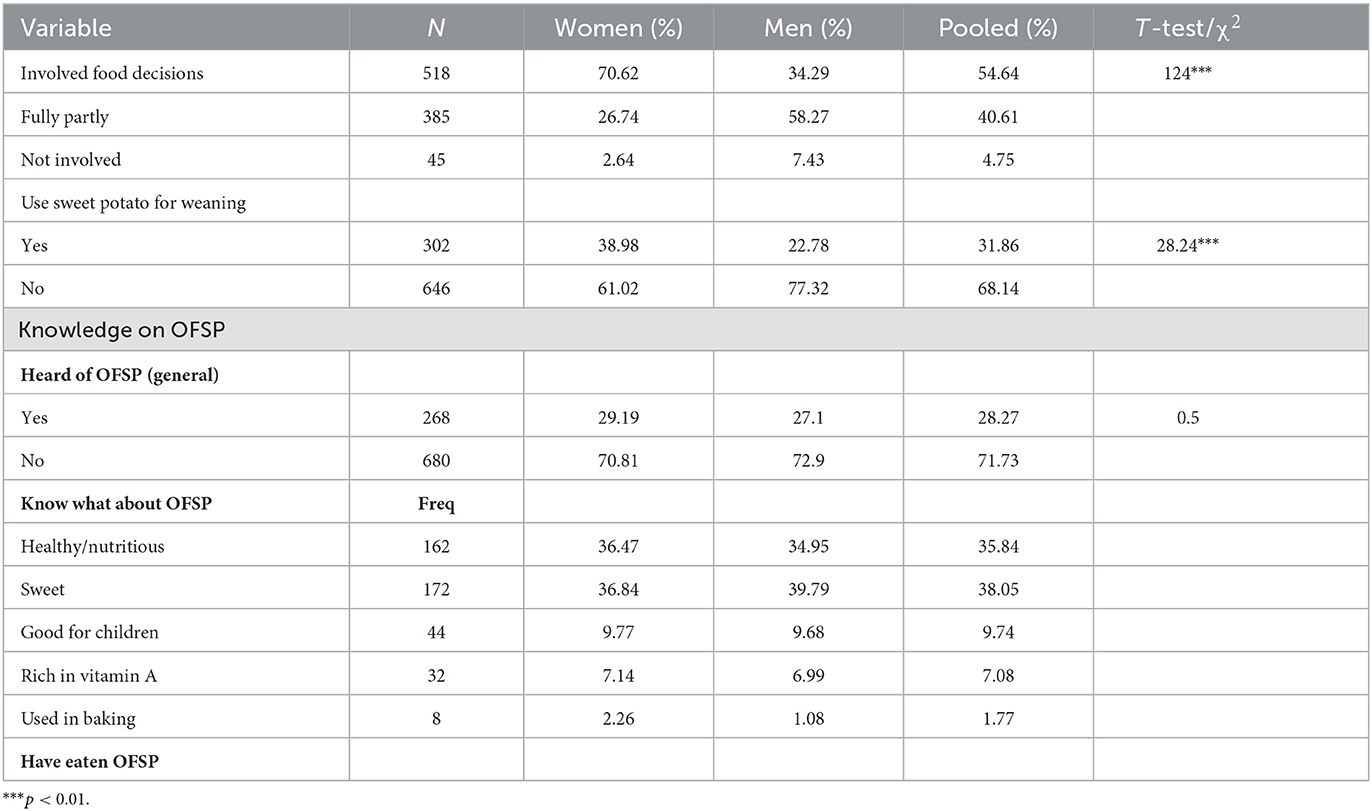
Table 3. Consumers' involvement in food purchasing decisions, knowledge, and consumption on OFSP and its products.
3.3. Knowledge and information pathways on OFSP roots and puree products
Street vendors (32.36%) are the primary source of sweet potato distribution to urban dwellers. Other sources include mobile and open-air sellers, hotels, or street vending kiosks (Figure 2). For massive promotion of awareness of the nutritional benefits of OFSP, these sources could act as pathways and agents of change at the point of sale. Knowledge of OFSP puree products among women and men was low; only 17.7% of women and 15.1% of men have heard about them, and there was only an average of 16.6% of the sampled respondents had knowledge of OFSP puree products (Table 4). Family and friends were the major information pathways for OFSP according to the sampled respondents. Street vendors and local kiosks also disseminated knowledge on OFSP as 20.9% of the respondents learned about OFSP from them. To increase consumer knowledge of OFSP, more innovative pathways need to be explored, for instance, the use of digital spaces such as social media. Our recommendation conforms to a study by Oteh et al. (2020) that to scale up demand for biofortified products, awareness creation is key to improving communication networks. As such studies have shown that both mainstream and digital media spaces can enhance consumers' knowledge and decision making (Yavisha and Krishna, 2013; Pambo et al., 2014; Mwaisaka, 2017), coupled with banners and awareness programs within nutritional departments in state and non-state institutions, could lead to far fetching effects on consumer awareness of OFSP puree products and associated benefits.
While street vendors were the major source of OFSP roots, those who had eaten OFSP puree products bought them ready mainly from supermarkets (60%), indicating that puree products are not available in major informal markets targeted for urban poor consumers. A few also prepared the OFSP puree products at home by boiling and mashing the roots into a puree (20%). While consumers could have preferred making the puree products by themselves, the OFSP puree was not available on the shelves, it's therefore hard to deduce consumer preference between buying or preparing OFSP puree products. The unavailability of puree on the shelves limits consumer acceptability and use of nutritious food. Other respondents had eaten the OFSP puree products as gifts (15%) or as samples in promotions (5%) representing women alone which can be an indicative gap on potential pathways in increasing awareness and acceptability of the OFSP puree products.
The household head was the leading buyer of the OFSP puree products in both female (19.35%) and male (45.16%) headed households (Table 5). Most households were headed by men (74.2%). While literature shows that women are more involved in household food purchase decisions (Blitstein and Evans, 2006), our study finds that men play a significant role in the acceptability and purchase of OFSP puree products in that they are the actual buyers or financial providers. This finding resonates with a study from Tanzania (Ochieng et al., 2017) that men are influential in purchasing nutrition-rich food. Although women are influential in making food purchase decisions, with dominance in resource access and management, men can enhance their household consumption of nutritious foods if well targeted in consumer profiling. Women were however more involved in preparing the OFSP puree products at 91.7%. Hence their incentive, knowledge, and workload should be considered to promote OFSP puree.
To understand the consumption pattern of OFSP puree products, consumers were asked about the frequency of use. A majority of the respondents consumed several times a week presenting a market potential for OFSP puree products if availability and knowledge are enhanced. Results show that OFSP puree products were consumed since they were sweet and healthy as shown in Table 6. Limited knowledge and limited understanding of the nutritional components of OFSP is exhibited especially among women as only consumed them due to the rich content of VA and only about 10% said that it was suitable for children. Sensitizing and enhancing awareness of the importance of VA for children can be a great incentive for women consumers.
3.4. Consumer willingness to accept and WTP for OFSP puree products
OFSP puree products are highly accepted by both women and men at 91.7% and 90.3%, respectively, with no significant statistical difference between gender (Table 7). On inquiry on the level of WTP for the three products used in the experimental auction, more women (60%) were very willing to pay for OFSP puree products than their men counterparts (50%). Further analysis of WTP is presented from the results of the BDM auction.
3.4.1. Consumer WTP, estimation from the BDM experimental auction
Three treatment categories—naive, nutritional information, and reference prices—were used to assess the WTP for the OFSP puree products (a six-piece packet of buns, a whole piece of chapati, and 400 g loaf of bread) as presented in Figure 3. Across all the OFSP puree products and treatment categories, WTP was a premium. In the naïve scenario, the respondents were willing to pay more for the six-piece packet of OFSP puree buns at KES 61.20 compared to KES 53.50 for the same quantity of non-OFSP buns. Similarly, the consumers were willing to pay a premium for a piece of OFSP chapati and the 400-g loaf of bread. On the nutritional information treatment scenario, consumers were willing to pay a premium for OFSP puree-based buns, chapati, and bread at KES 62.30, 21.40, and 58.10 compared to KES 52.90, 13.70, and 50 for conventional wheat products respectively. The difference in WTP bids was statistically significant. Similarly, under the reference price treatment category, consumers were willing to pay a premium for OFSP puree-based buns, chapati, and bread at KES 60.80, 21.70, and 58.60 compared to conventional wheat at KES 54.60, 17, and 54.10, respectively. However, the price difference due to reference price was less than that due to nutritional information treatment.
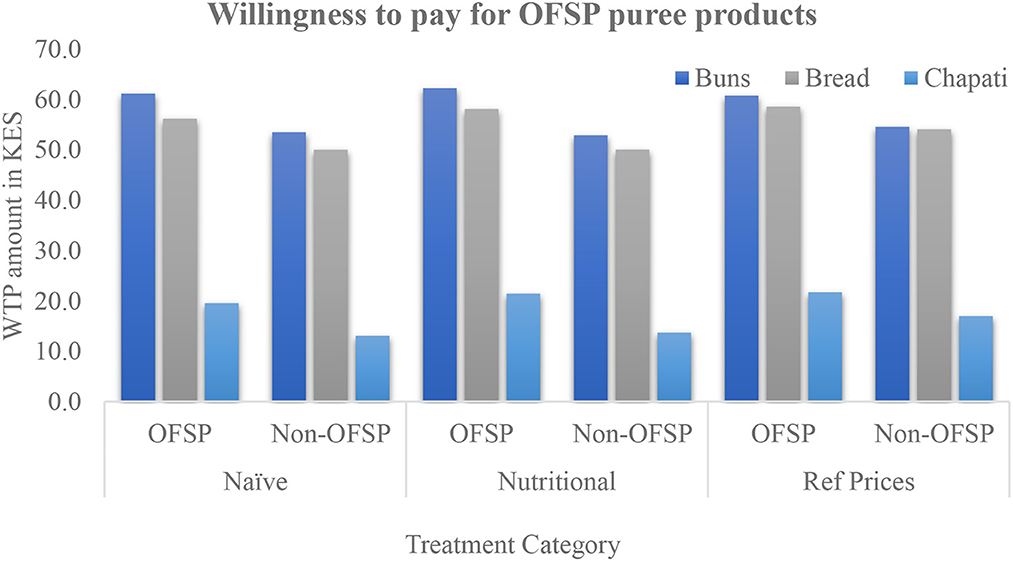
Figure 3. WTP for OFSP puree and non-OFSP products- BDM experimental auction of buns, chapati, and bread.
We conducted one-way analysis of variance (ANOVA) to test if there was any statistically significant difference in the means of the OFSP WTP bid price of the same product across the three treatment categories as shown in Table 8. Across the three treatment categories, there was a statistically significant difference in bid price for chapati and bread (p < 0.01). This could be explained due to the popularity of the two products in the Kenyan consumer market, especially among the urban poor. Buns on the other hand may not be a popular product, especially for the low consumer segment which was the target respondents for this study. To test whether there were any differences in WTP between men and women, a t-test statistics test was done, and the results are presented in Table 9. On OFSP puree products, there was a statistically significant difference in the WTP prices for bread between men and women with women willing to pay more (p < 0.01). This result confirms that women value OFSP products and marketing strategies should consider women's preferences and needs. Bread is a typical food for breakfast in most households especially in urban and peri-urban areas, explaining the willingness to pay a premium price by women.

Table 8. A comparison of the WTP prices for OFSP puree and non-OFSP buns, chapatis, and bread in Kenyan Shillings.

Table 9. Gender differences in the WTP prices among men and women on OFSP puree and non-OFSP buns, chapati, and bread.
3.4.2. Determinants of WTP premium bids for OFSP puree products
We conducted a Tobit regression to understand factors attributed to consumer WTP for premium prices on VA-rich OFSP puree buns, chapati, and bread and make a generalizable conclusion. Data were censored to the left since the BDM auction didn't allow for hostile prices. Socioeconomic characteristics, knowledge of OFSP, income category, nutritional information, and reference prices were regressed against the bids made for OFSP puree products as shown in Table 10. The age of the respondent significantly but negatively influenced the WTP for buns at a 95% confidence level. The inverse relationship between age and WTP depicts that older generations are not willing to pay for unfamiliar products. The results conform to many studies on the use of new products and innovations where a relatively older population is unlikely to try out new inventions Bocher et al. (2019) necessitating innovative product profiling and awareness programs. Education of the respondent on the other hand positively and significantly affects consumer WTP for both buns and chapati. Education level improves comprehension, interpretation, and access to information and therefore consumers who have better education could easily access and interpret the nutritional benefits of OFSP. Educated consumers are assumed to be aware of the nutritional attributes of OFSP puree products, and hence the willingness to pay more (Bett et al., 2013). However, most of our target consumers have limited educational attainment. Specific interventions for promoting OFSP are required to influence the decisions of this population.
The gender of the respondent negatively but significantly affects WTP for chapati. Being a male lowered the WTP for OFSP puree products. This could be explained by the nature of the food product which is mainly prepared by women. The inverse relationship further reveals gender norms and practices on household food decisions. To isolate the effect of gender on WTP, a regression analysis across the three treatments was done, and the results reveal that gender had a positive influence on WTP for OFSP puree chapati and buns only under the naïve scenario (Table 11). This could mean that other factors such as awareness of substitute product prices, and nutritional information about OFSP puree products overshadowed the effect of gender on WTP premium prices.
We grouped consumers into two categories, low- and mid-income consumers depending on their residence area. Consumers from the mid-income category were willing to pay for premium for OFSP chapatis; this presents a market potential for OFSP puree products while offering nutritional security to the vulnerable poor in the society to whom food availability is supreme to nutritional security. The findings supplement the study by Bocher et al. (2019) on OFSP juices in Rwanda where mid-income consumers are explained to be more conscious of the nutritional contents of food products. Reducing processing costs and increasing demand are required to reduce the prices of OFSP products as low-income consumers cannot afford premiums, but they and their children are more likely to have nutritional problems.
Knowledge of OFSP puree products has a negative but significant influence on WTP for OFSP chapati but a positive effect on bread. While both chapati and bread can be eaten for breakfast, chapatis are ideally eaten for main meals, and their preparation method differs from bread. The negative correlation could be attributed to misconception and attitude on the taste and texture, which is debunked in our study through the nutritional information regression analysis. In all three OFSP puree products, nutritional information positively and significantly influenced the WTP. This further shows that knowledge alone is not enough to derive consumer WTP for relatively new products rather quality information is a key driver. The availability of reference prices leads to premiums on the WTP for both bread and chapatis, similarly to Akaichi et al. (2012) who found that providing reference prices of substitute products positively affects WTP for high-quality white beans. Nutritional information plays a significant role in determining the WTP of VA-rich OFSP buns, chapatis, and bread as shown in this study. Correspondingly, providing nutrition information had a positive and significant effect on WTP for the improved flour among the base of pyramid (poor) consumers in Uganda (Chege et al., 2019). Similarly, Bocher et al. (2019) found out that WTP increased when consumers were provided with the nutritional information that OFSP juices have the highest pro-vitamin A contents.
4. Conclusion and policy recommendation
The prevalence of VA deficiency in many sub-Saharan African countries persists decades after massive innovations and campaigns against it. OFSP has been proven as an effective solution to VAD. Incorporating OFSP puree in baked and fried products may benefit the poor and urban population since affordability of nutritionally adequate diets is a big challenge majorly for the urban- poor and peri-urban dwelling households. This study sought to understand the urban poor and mid income consumers' knowledge and practices on OFSP and OFSP puree-based baked and fried products and their WTP for the products. We mimicked a real market scenario by adopting BDM experimental auction to deduce bid prices for three OFSP based products; buns, chapati and bread.
Results depict great potential for OFSP and OFSP puree products, if the value chain is strengthened to ensure sustainability. However, knowledge of both OFSP roots is low among urban consumers; in this study, with only 29% and 27% of women and men respondents, respectively, are aware of OFSP and OFSP puree products. OFSP puree products were still not very popular with 18% women and 15% men having heard about them. The poor knowledge levels are explained by the unavailability of both roots and puree products in local markets. Most respondents that are aware of OFSP puree products learned from friends and neighbors revealing weak information pathways. The urban poor and mid consumers spend significant time working and may not have strong social capitals to act as information sharing networks therefore innovative communication channels to create awareness on OFSP nutritional benefits need to be explored.
Interestingly, though the low knowledge levels on OFSP puree products, 90% of women and 92% of men respondents were willing to use OFSP puree products once they have source information. Results from BDM bidding prices show that in all three treatment categories, namely, naive, nutritional information, and reference prices, consumers were willing to buy OFSP products at a premium. Under the nutritional information scenario, consumers were willing to pay 18, 56, and 16% more for OFSP buns, chapatis, and bread, respectively, relative to the 100% wheat product. The reference pricing scenario also triggered the intention to pay 11, 28, and 8% more for buns, chapatis, and bread respectively relative to the conventional wheat products. Women were willing to pay more for OFSP compared to men. Owing to the high acceptance and WTP level, the results depict great potential for OFSP puree products if the OFSP value chain is strengthened to ensure consistent availability and supply of puree to the local processors. The OFSP value chain is a sure path to Vitamin. Deficiency management and prevention among children below the age of 5 years while ensuring food and nutritional security to the most vulnerable population.
Regression analysis on drivers of WTP showed that women play a significant role in determining WTP. While the nutritional components of the OFSP are important to mothers, OFSP's nutritional value can be an excellent incentive for mothers if they have knowledge of the importance of VA for children. Since women play significant roles in preparing food, especially for children, enhancing women's knowledge and skills in OFSP puree food preparation is also important. Selling ready-made OFSP puree can also help women to save time. Men and women have different incentives, so we need to promote additional messages—women buy for their children—the message is that VA is important for children and OFSP is rich in VA, women also prepare food; thus, women's voices need to be reflected to develop new readymade OFSP puree and OFSP products. Age is a negative but a significant influencer of WTP although the generation variables (youths and elderly) were insignificant; older consumers are less likely to accept and pay a premium to comparable new products. Education was seen as a significant variable in determining WTP. Awareness campaigns could use more educated community members as agents of change to trickle down the knowledge to their fellows. The mid-income consumers were also willing to pay a premium compared to the low-income consumers, this stresses the need to profile products according to the market segments and to increase sensitization that nutritious products are not necessarily expensive. As presented in our study, offering reference prices and nutritional information is a sure way to enhance ex ante demand.
Data availability statement
The raw data supporting the conclusions of this article will be made available by the authors, without undue reservation.
Author contributions
CW, AN, RS, MM, TM, and NK were involved in the contextualizing and designing of the study. CW and AN were involved in data collection, cleaning, analysis, and drafted the first manuscript. All authors critically reviewed and approved the final manuscript.
Funding
This study was supported by the International Potato Center (CIP) through the projects: Orange-Fleshed Sweet Potato (OFSP) Puree for Bakery Applications in East Africa for Nutrition, Post-Harvest Loss Management, Youth and Women Economic Empowerment, and BioInnovate Africa Program funded by the Swedish International Development Cooperation Agency (SIDA) and is based at the International Centre of Insect Physiology and Ecology (ICIPE), and CGIAR Research Program on Root, Tubers, and Bananas.
Acknowledgments
The authors would like to thank the International Potato Center (CIP-SSA) for funding the study.
Conflict of interest
The authors declare that the research was conducted in the absence of any commercial or financial relationships that could be construed as a potential conflict of interest.
Publisher's note
All claims expressed in this article are solely those of the authors and do not necessarily represent those of their affiliated organizations, or those of the publisher, the editors and the reviewers. Any product that may be evaluated in this article, or claim that may be made by its manufacturer, is not guaranteed or endorsed by the publisher.
References
Adebisi, O., Adebisi, L., Olatunji, I., Daodu, T., Omofaiye, A., and Akilapa, O. (2020). Sensory Evaluation and Willingness to Pay for Orange Flesh Sweet Potato. AGRIS. doi: 10.46909/cerce-2020-006
Akaichi, F., Gil, J. M., and Nayga, R. M. (2012). Assessing the market potential for a local food product: evidence from a non-hypothetical economic experiment. Br. Food J. 469–494. doi: 10.1108/00070701211197347
Amemiya, T. (1973). Regression analysis when the dependent variable is truncated normal. Econ. J. Econ. Soc. 997–1016. doi: 10.2307/1914031
Becker, G. M., DeGroot, M. H., and Marschak, J. (1964). I utility by a single-response sequential method. Behav. Sci. 9, 226–232. doi: 10.1002/bs.3830090304
Bett, H. K., Peters, K., Nwankwo, U., and Bokelmann, W. (2013). Estimating consumer preferences and willingness to pay for the underutilised indigenous chicken products. Food Policy 41, 218–225. doi: 10.1016/j.foodpol.2013.05.012
Birol, E., Meenakshi, J., Oparinde, A., Perez, S., and Tomlins, K. (2015). Developing country consumers' acceptance of biofortified foods: a synthesis. Food Sec. 7, 555–568. doi: 10.1007/s12571-015-0464-7
Blitstein, J. L., and Evans, W. D. (2006). Use of nutrition facts panels among adults who make household food purchasing decisions. J. Nutr. Educ. Behav. 38, 360–364. doi: 10.1016/j.jneb.2006.02.009
Bocher, T., Low, J. W., Muoki, P., Magnaghi, A., and Muzhingi, T. (2017). From lab to life: Making storable orange-fleshed sweetpotato purée a commercial reality. Open Agric. 2, 148–154. doi: 10.1515/opag-2017-0014
Bocher, T., Sindi, K., Muzhingi, T., Nshimiyimana, J. C., Nzamwita, M., and Low, J. (2019). Investigating consumer preferences and willingness to pay for orange-fleshed sweet potato (OFSP) juice in Rwanda. Open Agric. 4, 227–236. doi: 10.1515/opag-2019-0021
Bocher, T., Sindi, K., Nshimiyimana, J. C., and Low, J. (2016). “Consumer's preferences and willingness to pay for biofortified juice in Rwanda: does the nutritional information matter?” in 2016 Fifth International Conference (Addis Ababa).
Bouis, H. E., and Saltzman, A. (2017). Improving nutrition through biofortification: a review of evidence from HarvestPlus, 2003 through 2016. Glob. Food Secur. 12, 49–58. doi: 10.1016/j.gfs.2017.01.009
Burri, B. J. (2011). Evaluating sweet potato as an intervention food to prevent vitamin A deficiency. Compr. Rev. Food Sci. Food Saf. 10, 118–130. doi: 10.1111/j.1541-4337.2010.00146.x
Canavari, M., Drichoutis, A. C., Lusk, J. L., and Nayga, R. M. Jr. (2019). How to run an experimental auction: a review of recent advances. Eur. Rev. Agric. Econ. 46, 862–922. doi: 10.1093/erae/jbz038
Chege, C. G., Sibiko, K. W., Wanyama, R., Jager, M., and Birachi, E. (2019). Are consumers at the base of the pyramid willing to pay for nutritious foods? Food Policy 87, 101745. doi: 10.1016/j.foodpol.2019.101745
Chikweche, T., Stanton, J., and Fletcher, R. (2012). Family purchase decision making at the bottom of the pyramid. J. Consum. Mark. doi: 10.1108/07363761211221738
Chowdhury, S., Meenakshi, J., Tomlins, K. I., and Owori, C. (2011). Are consumers in developing countries willing to pay more for micronutrient-dense biofortified foods? Evidence from a field experiment in Uganda. Am. J. Agric. Econ. 93, 83–97. doi: 10.1093/ajae/aaq121
De Groote, H., Chege, C. K., Tomlins, K., and Gunaratna, N. S. (2014). Combining experimental auctions with a modified home-use test to assess rural consumers' acceptance of quality protein maize, a biofortified crop. Food Qual. Prefer. 38, 1–13. doi: 10.1016/j.foodqual.2014.04.014
De Groote, H., Kariuki, S. W., Traore, D., Taylor, J. R., Ferruzzi, M. G., and Hamaker, B. R. (2018). Measuring consumers' interest in instant fortified pearl millet products: a field experiment in Touba, Senegal. J. Sci. Food Agric. 98, 2320–2331. doi: 10.1002/jsfa.8722
De Groote, H., Kimenju, S. C., and Morawetz, U. B. (2011). Estimating consumer willingness to pay for food quality with experimental auctions: the case of yellow versus fortified maize meal in Kenya. Agric. Econ. 42, 1–16. doi: 10.1111/j.1574-0862.2010.00466.x
De Groote, H., Mugalavai, V., Ferruzzi, M., Onkware, A., Ayua, E., Duodu, K. G., et al. (2020). Consumer acceptance and willingness to pay for instant cereal products with food-to-food fortification in Eldoret, Kenya. Food Nutr. Bull. 41, 224–243. doi: 10.1177/0379572119876848
Depositario, D. P. T., Nayga, J., Rodolfo, M., Wu, X., and Laude, T. P. (2009). Effects of information on consumers' willingness to pay for golden rice. Asian Econ. J. 23, 457–476. doi: 10.1111/j.1467-8381.2009.02021.x
Goktolga, Z. G., Bal, S. G., and Karkacier, O. (2006). Factors effecting primary choice of consumers in food purchasing: The Turkey case. Food Cont. 17, 884–889. doi: 10.1016/j.foodcont.2005.06.006
Hagenimana, V., Low, J., Anyango, M., Kurz, K., Gichuki, S. T., and Kabira, J. (2001). Enhancing vitamin A intake in young children in western Kenya: orange-fleshed sweet potatoes and women farmers can serve as key entry points. Food Nutr. Bull. 22, 376–387. doi: 10.1177/156482650102200407
Jackson, J. C., Weatherspoon, L., Nnyepi, M., Malete, L., Mokgatlhe, L., Lyoka, P., et al. (2013). Sorghum bean composite porridge nutritional quality and acceptability. Nutr. Food Sci. 453–461. doi: 10.1108/NFS-03-2012-0024
Laurie, S., Faber, M., Adebola, P., and Belete, A. (2015). Biofortification of sweet potato for food and nutrition security in South Africa. Food Res. Int. 76, 962–970. doi: 10.1016/j.foodres.2015.06.001
Laurie, S. M., Faber, M., and Claasen, N. (2018). Incorporating orange-fleshed sweet potato into the food system as a strategy for improved nutrition: the context of South Africa. Food Res. Int. 104, 77–85. doi: 10.1016/j.foodres.2017.09.016
Low, J. W., Arimond, M., Osman, N., Cunguara, B., Zano, F., and Tschirley, D. (2007a). A food-based approach introducing orange-fleshed sweet potatoes increased vitamin A intake and serum retinol concentrations in young children in rural Mozambique. J. Nutr. 137, 1320–1327. doi: 10.1093/jn/137.5.1320
Low, J. W., Arimond, M., Osman, N., Cunguara, B., Zano, F., and Tschirley, D. (2007b). Ensuring the supply of and creating demand for a biofortified crop with a visible trait: lessons learned from the introduction of orange-fleshed sweet potato in drought-prone areas of Mozambique. Food Nutr. Bull. 28, S258–S270. doi: 10.1177/15648265070282S205
Low, J. W., Mwanga, R. O. M., Andrade, M., Carey, E., and Ball, A.-M. (2017). Tackling vitamin A deficiency with biofortified sweetpotato in sub-Saharan Africa. Food Secur. Gov. Lat. Am. 14, 23–30. doi: 10.1016/j.gfs.2017.01.004
Low, J. W., and van Jaarsveld, P. J. (2008). The potential contribution of bread buns fortified with β-carotene-rich sweet potato in Central Mozambique. Food Nutr. Bull. 29, 98–107. doi: 10.1177/156482650802900203
Lusk, J. L., House, L. O., Valli, C., Jaeger, S. R., Moore, M., Morrow, J. L., et al. (2004). Effect of information about benefits of biotechnology on consumer acceptance of genetically modified food: evidence from experimental auctions in the United States, England, and France. Eur. Rev. Agric. Econ. 31, 179–204. doi: 10.1093/erae/31.2.179
Lusk, J. L., and Hudson, D. (2004). Willingness-to-pay estimates and their relevance to agribusiness decision making. Appl. Econ. Perspect. Policy 26, 152–169. doi: 10.1111/j.1467-9353.2004.00168.x
Mabaya, E., Jordaan, D., Malope, P., Monkhei, M., and Jackson, J. (2010). Attribute preferences and willingness to pay for fortified cereal foods in Botswana. Agrekon 49, 459–483. doi: 10.1080/03031853.2010.526692
Maredia, M. K., and Bartle, B. (2023). Excess demand amid quality misperceptions: the case for low-cost seed quality signalling strategies. Eur. Rev. Agric. Econ. 50, 360–394. doi: 10.1093/erae/jbac019
Meenakshi, J., Banerji, A., Manyong, V., Tomlins, K., Mittal, N., and Hamukwala, P. (2012). Using a discrete choice experiment to elicit the demand for a nutritious food: Willingness-to-pay for orange maize in rural Zambia. J. Health Econ. 31, 62–71. doi: 10.1016/j.jhealeco.2012.01.002
Miller, K. M., Hofstetter, R., Krohmer, H., and Zhang, Z. J. (2011). How should consumers' willingness to pay be measured? An empirical comparison of state-of-the-art approaches. J. Mark. Res. 48, 172–184. doi: 10.1509/jmkr.48.1.172
Miškolci, S. (2011). Consumer preferences and willingness to pay for the health aspects of food. Acta Universitatis Agriculturae et Silviculturae Mendelianae Brunensis. 59, 167–176.
Morawetz, U. B., De Groote, H., and Kimenju, S. C. (2011). Improving the use of experimental auctions in Africa: theory and evidence. J. Agric. Resour. Econ. 263–279.
Muzhingi, T., Mbogo, D., Low, J., Magnaghi, A., Heck, S., and Gule, S. (2016). Effect of baking on the β-carotene content of orange flesh sweetpotato (Ipomoea batatas) purée bread and OFSP flour bread. FASEB J. 30, lb433. doi: 10.1096/fasebj.30.1_supplement.lb433
Muzhingi, T., Owade, J. O., Abong, G. O., Okoth, M. W., Heck, S., Low, J., et al. (2018). Sensory attributes of composite breads from shelf storable orange-fleshed sweetpotato puree. Open Agric. 3, 459–465. doi: 10.1515/opag-2018-0051
Mwaisaka, F. W. (2017). The influence of social media on the consumer decision making process in the cosmetic industry in Nairobi County, Kenya (Doctoral dissertation). University of Nairobi, Nairobi, Kenya.
My, N. H., Demont, M., Van Loo, E. J., de Guia, A., Rutsaert, P., Tuan, T. H., et al. (2018). What is the value of sustainably-produced rice? Consumer evidence from experimental auctions in Vietnam. Food Policy 79, 283–296. doi: 10.1016/j.foodpol.2018.08.004
Neela, S., and Fanta, S. W. (2019). Review on nutritional composition of orange-fleshed sweet potato and its role in management of vitamin A deficiency. Food Sci. Nutr. 7, 1920–1945. doi: 10.1002/fsn3.1063
Nkokelo, U. (2016). Consumer Acceptability and Willingness to Pay for Selected Processed Orange Fleshed Sweet Potato Products in Morogoro Municipality. Sokoine University of Agriculture.
Ochieng, J., Afari-Sefa, V., Lukumay, P. J., and Dubois, T. (2017). Determinants of dietary diversity and the potential role of men in improving household nutrition in Tanzania. PLoS ONE 12, e0189022. doi: 10.1371/journal.pone.0189022
Oteh, O. U., Hefferon, K., and Agwu, N. M. (2020). Moving biofortified cassava products closer to market in Nigeria. Front. Sustain. Food. Syst. 4, 589424. doi: 10.3389/fsufs.2020.589424
Owade, J. O., Abong, G. O., and Okoth, M. W. (2018). Production, utilization and nutritional benefits of orange fleshed sweetpotato (OFSP) puree bread: a review. Curr. Res. Nutr. Food Sci. 6, 644. doi: 10.12944/CRNFSJ.6.3.06
Pambo, K. O., Otieno, D. J., and Okello, J. J. (2014). Consumer Awareness of Food Fortification in Kenya: The Case of Vitamin-A-Fortified Sugar.
Poole, N. D., Mart,i, L., and Giménez, F. V. (2007). Quality perceptions under evolving information conditions: implications for diet, health and consumer satisfaction. Food Policy 32, 175–188. doi: 10.1016/j.foodpol.2006.05.004
Rani, S., Shah, H., Habib, N., and Khan, M. (2018). Consumers' Preferences and willingness to pay for organic vegetables in Islamabad, Pakistan. Sarhad J. Agric. 34, 494–499. doi: 10.17582/journal.sja/2018/34.3.494.499
Shogren, J. F. (2005). Experimental methods and valuation. Handb. Environ. Econ. 2, 969–1027. doi: 10.1016/S1574-0099(05)02019-X
Skuza, N., McCracken, V., and Ellis, J. (2015). Compensation fees and willingness to pay: a field experiment on organic apples. Int. J. Food Agric. Econ. 3, 1–13.
Tobin, J. (1958). Estimation of relationships for limited dependent variables. Econ. J. Econ. Soc. 24–36. doi: 10.2307/1907382
Wang, L., and Huo, X. (2016). Willingness-to-pay price premiums for certified fruits-A case of fresh apples in China. Food Control 64, 240–246. doi: 10.1016/j.foodcont.2016.01.005
Wanjuu, C., Abong, G., Mbogo, D., Heck, S., Low, J., and Muzhingi, T. (2018). The physiochemical properties and shelf-life of orange-fleshed sweet potato puree composite bread. Food Sci. Nutr. 6, 1555–1563. doi: 10.1002/fsn3.710
Wanjuu, C., Bocher, T., Low, J., Mbogo, D., Heck, S., and Muzhingi, T. (2019). Consumer knowledge and attitude towards orange-fleshed sweetpotato (OFSP) Puree Bread in Kenya. Open Agric. 4, 616–622. doi: 10.1515/opag-2019-0061
Wardle, J., Haase, A. M., Steptoe, A., Nillapun, M., Jonwutiwes, K., and Bellisie, F. (2004). Gender differences in food choice: the contribution of health beliefs and dieting. Ann. Behav. Med. 27, 107–116. doi: 10.1207/s15324796abm2702_5
Keywords: OFSP puree, vitamin A deficiency, gender, willingness to pay, Becker–DeGroot–Marschack auction, consumers, nutrition, urban-poor
Citation: Wangithi CM, Nyangaresi MA, Srinivasulu R, Moyo M, Muzhingi T and Kawarazuka N (2023) Consumer willingness to pay a premium for orange-fleshed sweet potato puree products: a gender-responsive evidence from Becker–DeGroot–Marschak experimental auction among low- and middle-income consumers in selected regions of Nairobi, Kenya. Front. Sustain. Food Syst. 7:1114468. doi: 10.3389/fsufs.2023.1114468
Received: 02 December 2022; Accepted: 20 April 2023;
Published: 30 May 2023.
Edited by:
Gloria Essilfie, University of Ghana, GhanaCopyright © 2023 Wangithi, Nyangaresi, Srinivasulu, Moyo, Muzhingi and Kawarazuka. This is an open-access article distributed under the terms of the Creative Commons Attribution License (CC BY). The use, distribution or reproduction in other forums is permitted, provided the original author(s) and the copyright owner(s) are credited and that the original publication in this journal is cited, in accordance with accepted academic practice. No use, distribution or reproduction is permitted which does not comply with these terms.
*Correspondence: Nozomi Kawarazuka, bi5rYXdhcmF6dWthQGNnaWFyLm9yZw==
†These authors share first authorship
 Charity M. Wangithi
Charity M. Wangithi Annette M. Nyangaresi
Annette M. Nyangaresi Rajendran Srinivasulu
Rajendran Srinivasulu Mukani Moyo
Mukani Moyo Tawanda Muzhingi
Tawanda Muzhingi Nozomi Kawarazuka
Nozomi Kawarazuka
